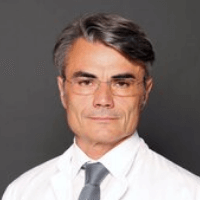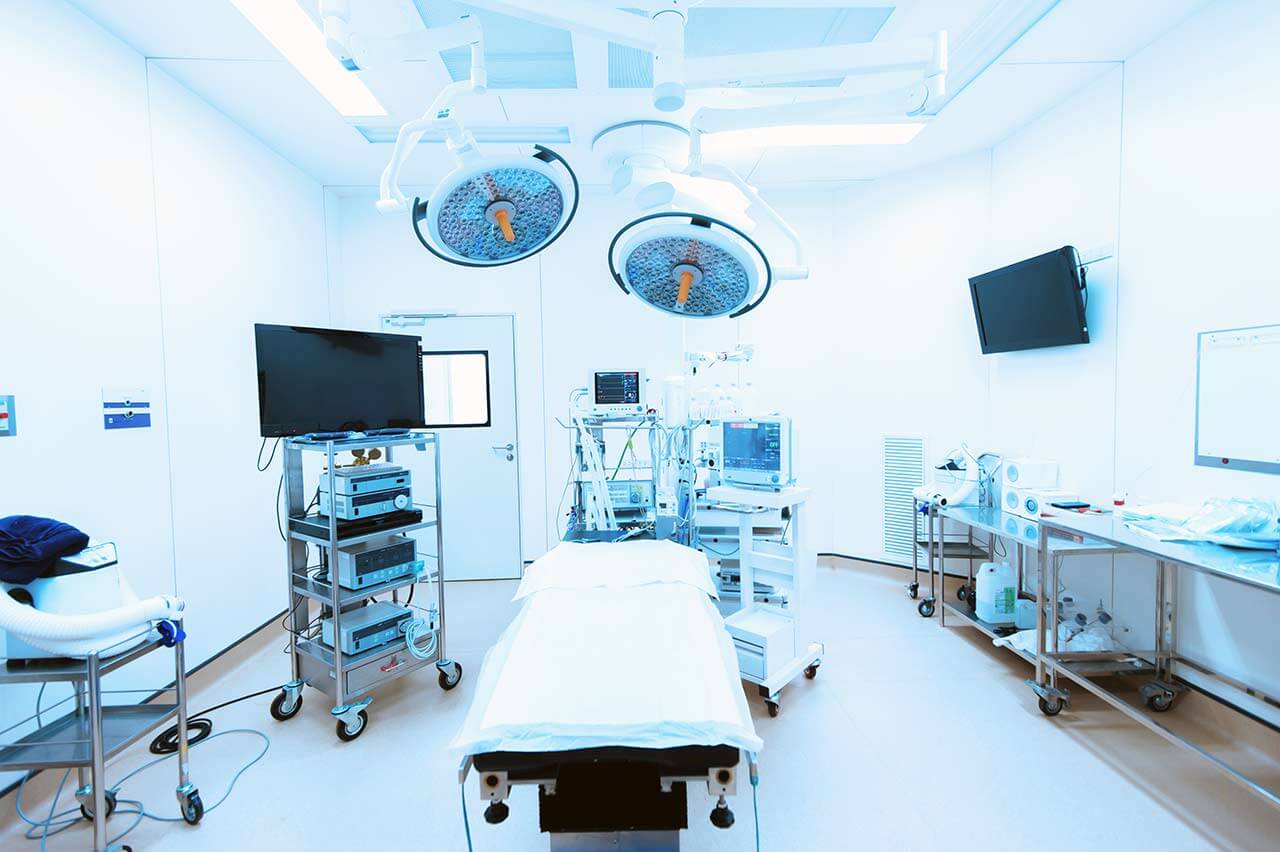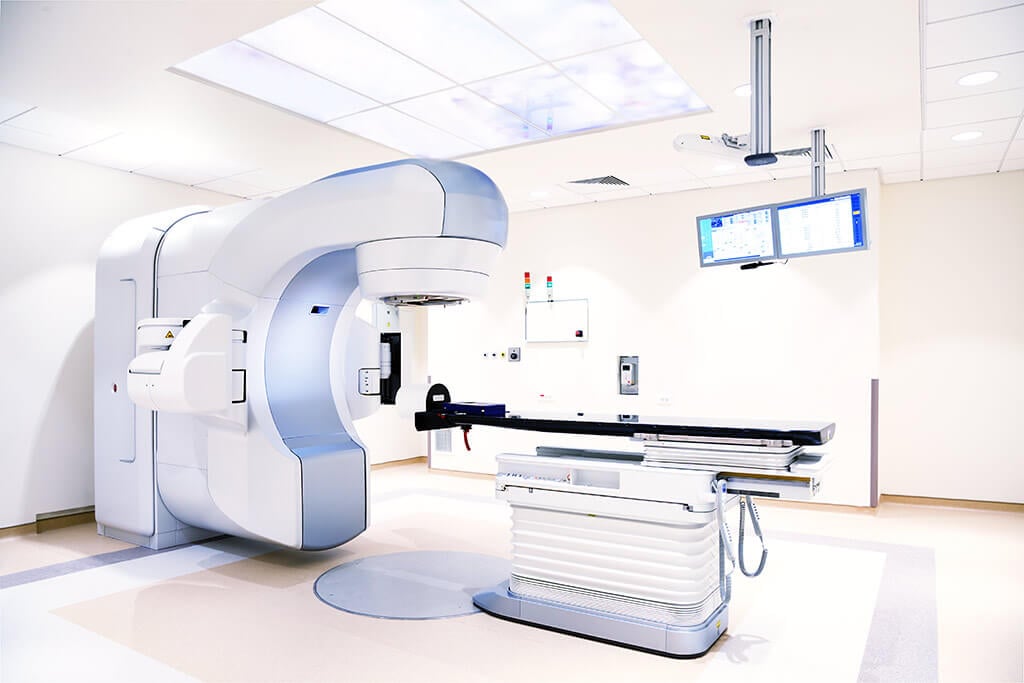
The program includes:
- Initial presentation in the clinic
- clinical history taking
- review of medical records
- physical examination
- laboratory tests:
- complete blood count
- general urine analysis
- biochemical analysis of blood
- TSH-basal, fT3, fT4
- tumor markers
- inflammation indicators (CRP, ESR)
- indicators of blood coagulation
- abdominal ultrasound scan
- CT scan/MRI or PET-CT of abdomen
- preoperative care
- cytoreductive surgery to remove visible tumors
inside the abdomen and HIPEC - histological and immunohistochemical
examination of removed tissues - symptomatic treatment
- cost of essential medicines
- nursing services
- stay in the hospital with a full board
- accommodation in a 2-bedroom ward
- elaboration of further recommendations
How program is carried out
During the first visit, the physician will conduct a clinical examination and go through the results of the available diagnostic tests. After that, you will undergo the necessary additional examination, such as the assessment of liver and kidney function, ultrasound scan and tomography of the abdominal organs. Based on the results of the examination, the physician will choose the surgical technique and the type of anesthesia. After that, preparation according to the preoperative standard will start.
Cytoreductive surgery begins with general anesthesia. The intervention is performed as open surgery, i.e. through the incision in the anterior abdominal wall, so that the surgeon can carefully examine the peritoneum and the surface of the abdominal organs. The surgeon removes affected by the malignant process areas of the peritoneum and metastases in other internal organs. This stage of the operation can take several hours, since the overall effectiveness of the treatment depends on the completeness of the malignant tissues removal.
At the next stage of the operation, the surgeon inserts several catheters into the abdominal cavity. Through the catheters, a heated solution of a chemotherapy drug is pumped inside. The special system maintains the required temperature (42-43 degrees Celsius), pressure and circulation rate of the medicinal solution. The solution mechanically flushes out blood clots and remnants of malignant tissues, and a heated chemotherapy drug destroys micrometastases in internal organs and lymph nodes (micrometastases can’t be detected by the naked eye).
After 1-1.5 hours, the chemotherapy drug is removed from the abdominal cavity and the abdominal cavity is washed with saline. After that, the surgeon removes the catheters and sutures the incision of the anterior abdominal wall.
After the completion of the operation, you will be transferred to the ward of the intensive care unit, under the round-the-clock supervision of doctors and nurses. In 1-3 days after the operation, your drains will be removed and you will be transferred to a regular ward for further recovery. The whole treatment takes 10-12 days on average.
Finally, the attending physician will evaluate the results of control examinations, schedule the date of discharge from the hospital and give you detailed recommendations for further follow-up and treatment.
Required documents
- Medical records
- X-ray examination, MRI/CT scan (if available)
- Pleural biopsy (if available)
Service
You may also book:
 BookingHealth Price from:
BookingHealth Price from:
About the department
The Department of Thoracic Surgery at the Catholic Clinic Koblenz-Montabaur offers the full range of surgical treatment for patients with benign and malignant diseases of the lungs, pleural cavities, and mediastinum. The department is part of the Lung Cancer Center certified in accordance with the standards of the German Cancer Society (DKG), and therefore it provides high-quality treatment for lung malignancies. The team of the department's thoracic surgeons also has vast experience in the surgical treatment of benign respiratory system diseases, including pleurisy, lung abscesses, emphysema, pneumothorax, and other pathologies. The department's surgeons are internationally recognized experts in the field of minimally invasive operations, namely video-assisted thoracoscopic surgery (VATS). The first minimally invasive lung lobe removal in Rhineland-Palatinate was performed in this department. Such operations are done through small incisions between the ribs, due to which the patient experiences minimal pain, can breathe better, and recovers faster in the postoperative period. The department's specialists cooperate closely with pulmonologists and radiologists, thanks to which patients receive comprehensive medical care. The focus of doctors is always on the patient and his individual wishes and needs.
The department is headed by PD Dr. med. Martin Hürtgen who, together with the medical team, has developed the following innovative surgical procedures: video-assisted mediastinoscopic lymphadenectomy and mediastinoscopic sonography. The specialists, not only from Germany and Europe but also from Japan, strive to master these newly developed techniques, for which they come to the medical facility on their own or invite surgeons from the department to exchange their experience.
Lung cancer is one of the most frequently diagnosed and dangerous types of cancer. The first-line treatment for lung cancer is usually surgical resection of the tumor, a lung segment with a tumor, or a lung lobe, depending on the spread of the cancer process. The choice of the optimal operation and the development of a concomitant conservative treatment scheme take place at an interdisciplinary tumor board with the participation of thoracic surgeons, pulmonologists, oncologists, radiologists, radiation therapists, psycho-oncologists, and other specialists. With appropriate clinical indications, the department's thoracic surgeons perform the operation using low-traumatic video-assisted thoracoscopic surgical techniques (VATS): through small incisions and without opening the chest. If the stage of oncopathology does not allow for minimally invasive treatment, the department's specialists resort to open surgery. The success rates for open lung cancer interventions performed in the department are also at their highest level. In most cases, in addition to the resection of the malignant neoplasm, the patient is prescribed chemotherapy and/or radiation therapy.
The department's thoracic surgeons can also be proud of their exceptional success in the surgical treatment of lung, mediastinal, and chest wall metastases. The specialists mostly operate on patients with lung metastases due to breast, colon, kidney, prostate, stomach, and other types of cancer. Metastases can affect any area of the lung. These can be single or multiple. If a patient has single lung metastases, the department's surgeons will remove them using minimally invasive techniques. The medical facility uses advanced laser technologies to remove multiple metastatic foci. During such interventions, a special laser is used, with which surgeons make bloodless tissue incisions. Thoracoscopic imaging is used to determine the exact location of the tumor and direct the laser beam to it. The therapeutic effect is achieved due to the impact of laser beams on the metastatic focus, which results in the heating and destruction of cancer cells in the lungs. Laser metastasis removal is of particular value in the treatment of secondary lung tumors causing tracheal or airway obstruction.
The department's team of surgeons performs operations for a variety of benign pathologies of the respiratory system, including pneumothorax, pulmonary emphysema, pleural effusion, pleural empyema, solitary pulmonary nodules, and other diseases. Surgical interventions for the above pathologies are always performed using minimally invasive techniques. When performing operations, the department's surgeons make 2-3 skin incisions several centimeters long, after which a miniature camera and special surgical instruments are delivered to the pathological focus. The camera ensures the transfer of images of the operated field to the screen, and multiple zooming of images allows the surgeon to perform manipulations with pinpoint precision. Minimally invasive surgical procedures are performed under general anesthesia. Following the operation, the patient is under medical supervision for 1-3 days, after which they are given recommendations for follow-up treatment and discharged from the hospital.
The department's range of surgical services includes the following options:
- Surgical treatment for lung cancer
- Sparing treatment using minimally invasive surgical techniques at early stages
- Video-assisted mediastinoscopic lymphadenectomy
- Thoracoscopic lobectomy
- Combination treatment for advanced stages of lung cancer
- Preoperative chemotherapy or radiation therapy
- Extensive lung tumor resection along with part of the chest wall or other chest organs
- Postoperative treatment with chemotherapy or radiotherapy
- Sparing treatment using minimally invasive surgical techniques at early stages
- Surgical treatment for lung, chest wall, and mediastinal metastases
- Lung metastases
- Minimally invasive thoracoscopic resection of single metastases
- Laser removal of multiple metastases
- Chest wall metastases
- Minimally invasive palliative removal of individual ribs
- Chest wall extensive resections and chest wall radiation necrosis with subsequent plastic repair (in cooperation with plastic surgeons)
- Mediastinal metastases
- Videomediastinoscopic diagnosis and palliative resection of lymph node metastases
- Lung metastases
- Tracheal surgery
- Resection of the tracheal segment with end-to-end anastomosis
- Surgical correction of tracheal and laryngeal stenosis (in cooperation with the Department of Otolaryngology)
- Palliative endobronchial recanalization and stent implantation
- Surgical treatment of chest wall and mediastinal tumors
- Surgery for primary chest wall tumors
- Extensive therapeutic resection of mediastinal tumors using sternotomy or thoracoscopic thymectomy (depending on the results of a histological examination and the stage of cancer)
- Minimally invasive sampling for a histological examination before chemotherapy or radiotherapy
- Lung, chest wall, and tracheal laser surgery
- Video-assisted thoracoscopic surgery
- Surgery for pneumothorax
- Surgery for hyperhidrosis
- Surgery for diaphragmatic paralysis
- Surgery for pulmonary emphysema
- Surgery for solitary pulmonary nodules
- Surgery for pleural effusion and pleural empyema
- Video-assisted mediastinoscopic lymphadenectomy
- Thoracoscopic lobectomy
- Bronchoscopic interventions
- Tracheal stent implantation
- Recanalization for stenosing tumors
- Bronchoscopy under general anesthesia (if necessary, with foreign body removal)
- Other medical services
Curriculum vitae
Higher Education, Postgraduate Training and Professional Career
- 1978 - 1984 Medical studies at the University of Wuerzburg.
- 1983 - 1984 Internship, Department of Surgery, University of Basel, Kanton Hospital, Switzerland; Department of Neurology at the University Hospital Wuerzburg; Department of Internal Medicine at the University Hospital Wuerzburg.
- May 1984 Final Exam, University of Wuerzburg.
- February 1985 Doctoral thesis defense and doctorate, University of Wuerzburg.
- March 1988 Major of Military Medical Service.
- October 1992 Board certification in Surgery, Hessen Medical Association.
- 1994 - 2002 Senior Surgeon, Department of Thoracic Surgery at the Hospital Schillerhoehe, Gerlingen/Stuttgart, Germany.
- 1996 Board certification in Thoracic Surgery, Medical Association of North Wuerttemberg.
- Since 2002 Head Physician of the Department of Thoracic Surgery at the Catholic Clinic Koblenz-Montabaur.
- February 2007 Lieutenant Colonel of the Military Medical Service.
- March 2011 Habilitation, PD, University of Mainz.
- Since 2014 Member of the HERMES Task Force Group on Thoracic Surgery, European Respiratory Society (ERS).
Clinical Focuses
- Surgical treatment of lung cancer.
- Surgical treatment of metastases in the lungs, chest wall, and mediastinum.
- Surgical treatment of tracheal diseases.
- Surgical treatment of chest wall and mediastinal tumors.
- Lung and tracheal laser surgery.
- Video-assisted thoracoscopic surgery (VATS).
- Bronchoscopy interventions.
Memberships in Professional Societies
- German Society of Surgery (DGCH).
- German Society for Pneumology and Respiratory Medicine (DGP).
- German Society for Thoracic Surgery (DGT).
- European Society of Thoracic Surgeons (ESTS).
- European Respiratory Society (ERS).
- International Association for the Study of Lung Cancer (IASLC).
Photo of the doctor: (c) Katholisches Klinikum Koblenz - Montabaur
About hospital
The Catholic Clinic Koblenz-Montabaur is a modern medical facility with an excellent reputation in Germany and abroad. The medical center is an academic clinic of the University Hospital Mainz, which gives patients the opportunity to take advantage of scientific advances and innovative treatments. The clinic has the widest possibilities for providing effective medical care to patients with both common and especially complex and rare pathologies. In December 2017, the clinic was certified in accordance with DIN EN ISO 9001:2015 standards, and in 2020, it was successfully recertified, which is a confirmation of the high quality of medical service. The clinic has 20 departments with 17 highly specialized centers integrated into them. The bed fund of the medical facility includes 657 beds. More than 32,000 inpatients and about 133,000 outpatients receive medical care here annually.
Many medical specialties are available at the clinic, including general and abdominal surgery, bariatric surgery, vascular surgery, thoracic surgery, cardiology, pulmonology, gynecology, urology, neurology, orthopedics, traumatology, radiology, nuclear medicine, and others. Each of the medical specialties is represented by an experienced team of doctors and nursing staff who do their best to restore the patient's health. Doctors of various medical fields work in close cooperation, which allows for an interdisciplinary approach to solving health problems.
The pride of the clinic is the advanced technical base, which plays an important role in accurate examinations and effective treatment. For example, the operating rooms at the clinic are equipped in accordance with the current requirements of European medicine, due to which most surgical interventions are performed using sparing techniques, including laser surgery, video-assisted thoracoscopic surgery, arthroscopy, endovascular and hybrid surgical techniques, etc.
Despite the clinic's high-tech infrastructure, there is an atmosphere of understanding, sympathy, and respect for the patient. The medical team shows a humane attitude towards patients and takes care of their comfort throughout the entire period of treatment. Doctors devote enough time to personal communication with patients, which makes it possible to take into account their individual needs and wishes during the therapeutic process.
Photo: (с) depositphotos
Accommodation in hospital
Patients rooms
The patients of the Catholic Clinic Koblenz-Montabaur live in comfortable single and double rooms with light colors and modern design. Each patient room has an ensuite bathroom with a shower and a toilet. The furnishings of a standard patient room include an automatically adjustable bed, a bedside table, a wardrobe, a table and chairs for receiving visitors, and a TV. The telephone is provided for a fee. Wi-Fi is available upon request.
The clinic also offers enhanced comfort rooms corresponding to the level of a five-star hotel. These patient rooms are more spacious and have a sophisticated design. The bathroom of the enhanced comfort rooms has a set of toiletries, changeable towels, and a bathrobe.
Meals and Menus
The patient and the accompanying person can choose meals from three menus daily. If, for some reason, you do not eat all the foods, you will be offered an individual menu. Please inform the nursing staff of your dietary preferences prior to treatment.
Patients living in enhanced comfort rooms are additionally offered free soft drinks, coffee, tea, desserts, and fresh fruits.
Further details
Standard rooms include:
Religion
A Catholic liturgy is held every Sunday morning in the church at the clinic. The divine liturgy is also broadcast on the clinic's internal TV channel.
Accompanying person
Your accompanying person may stay with you in your patient room or at the hotel of your choice during the inpatient program.
Hotel
You may stay at the hotel of your choice during the outpatient program. Our managers will support you for selecting the best option.





